IntroductionIn this article, I will be covering in detail why each link in a 4-link live axle suspension system must have torsional compliance for proper articulation. Table of ContentsBelow is a diagram showing a basic 4-link live axle suspension setup. All four links are parallel to the centerline of the vehicle. The lower links are in dark red, and the uppers are in bright red. 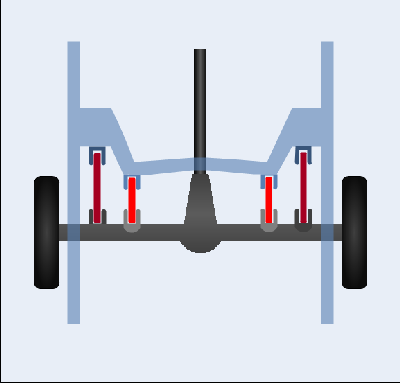
Lateral Location of the AxleWith the above suspension setup, there is no direct lateral restraint for the axle. A lateral force would put stress on the links themselves, and the joints at each end, as seen below. 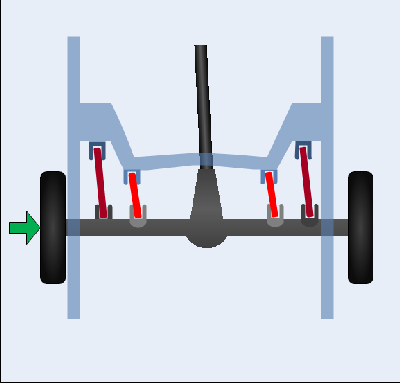
The problem of lateral location with 4-link suspensions can be solved in one of two ways. The first option is to use a panhard rod. This rod directly provides lateral location to the axle. A linkage known as a Watt's Linkage can also be used. Many vehicles, including my Nissan Pathfinder use a panhard rod setup with (nearly) parallel links. 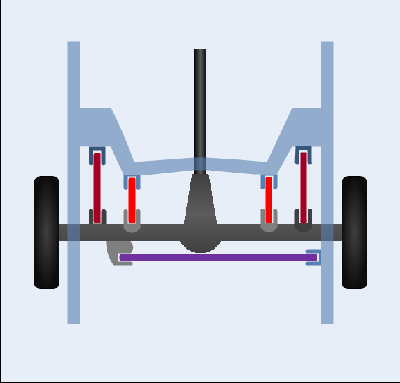
Parallel-link setup with panhard rod. Some setups of this type will do away with one of the upper links, and will have the other moved closer to the lateral centre of the axle. The second option is to place the links on oblique angles. This provides lateral location to the axle as well, but puts much greater stress on each of the links in comparison to using an exclusive lateral locating link. This setup is also quite common, and can be found on my Chevy Caprice. 
Suspension TravelWhen only one of the wheels travels over a bump, the axle will be on an angle with respect to the chassis, when viewed from the front or from the rear. 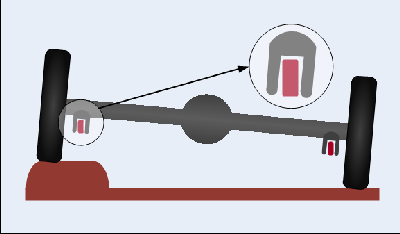
If one wheel hits a bump, there will be a torsion applied through the bushing to the link and onward to the frame. With parallel-link setups, there will be no torsion applied to the links when the axle is moving vertically, but there will be torsion when the axle is rolling. With oblique-link suspension setups, there will be a torsion applied to all links any time the axle is articulating, whether the axle is moving vertically or rolling. The fact that the links are oblique means that their axis of rotation is not coaxial, a seen in the diagram below. 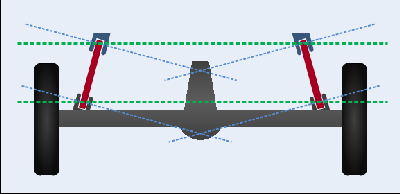
When moving vertically, the lower links must pivot about the green line, but their natural axis of rotation is shown by the blue lines. This difference in angles causes a torsion to be applied to the links. In this diagram, only the lower links are illustrated, for clarity. Normally, the upper links are much shorter and are on a significantly sharper angle, making the effects shown here even more dramatic. 
Torsional ComplianceAt this point, it is clear that the links in a 4-link suspension system must in some manner be allowed to twist so that the axle can travel vertically or roll. This compliance can come from a few different places in the linkage system.
Generally speaking, the bushings in a suspension system would be expected to provide the necessary compliance to allow the torsion to take place. The problem, however, lies in the fact that soft rubber bushings are so flexible that they allow the axle to move in ways that are undesirable. This includes lateral motion, vertical motion (hop) or a combination of the two. It is not possible to dampen or otherwise control this motion, which means that it will have a negative effect on handling. It is common to solve the aforementioned problem by replacing rubber bushings with much harder polyurethane bushings (or solid bushings in some cases). This makes the suspension system much more rigid, and resolves the issue of undesirable motion of the axle. Unfortunately, this means that the bushings may no longer be providing adequate torsional compliance. 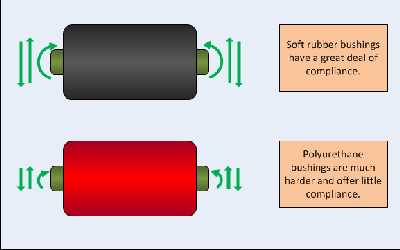
Many vehicles with 4-link suspension use links which are intentionally made to be flexible themselves. The problem with using flexible links is that they are often very weak, and cannot handle high loads from off-road use, or hard acceleration. Also, much like having soft bushings, their motion cannot be precisely controlled. The twisting of the link acts as an undamped spring. In performance applications, factory-style flexible links are often replaced with boxed links which are very rigid in tension, torsion, and bending. This can significantly improve handling by maintaining accurate suspension geometry. 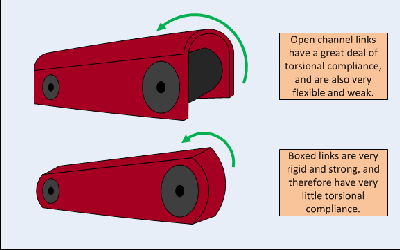
If, however, rigid links are used with rigid polyurethane (or solid) bushings, there is nothing left to provide the necessary torsional compliance other than the frame mount points themselves. Over time, this can lead to fatigue and cracking of the frame mount, which could be very dangerous. Such setups should be avoided. The only linkage setup that can provide accurate geometry and proper torsional compliance is a rigid link with a heim joint at at least one end. Unfortunately, heim joints do not last long when used on street vehicles, and are very expensive as they need to be quite large and strong. 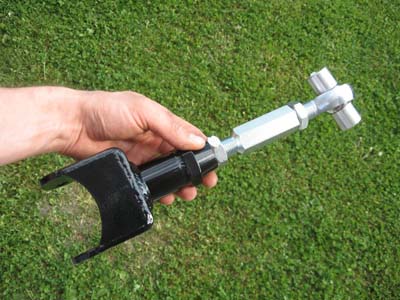
An adjustable-length rigid upper link utilizing a heim joint at one end and either a rubber or polyurethane bushing at the other (bushing not pictured). Wheel Rate and BindingWheel rate is the vertical force needed to displace the wheel vertically. Normally, the wheel rate can be calculated by multiplying the spring rate by the ratio of the spring's displacement relative to the wheel. In the case of a MacPherson strut where the wheel is effectively attached directly to the spring, the wheel rate would be equal to the spring rate. With a 4-link live axle, the wheel rate is much more difficult to calculate. The coil (or leaf) spring behaves differently depending on whether one or both ends of the axle are in bump. Further, the spring effect from bushing, link, and/or frame mount compliance would need to be accounted for, as it is significant with this suspension type. If a suspension system is not allowing proper articulation, then it is said to be binding. Strictly speaking, the suspension is said to have bound ("binded") if the freedom of motion of the system is suddenly restricted. This would cause the wheel rate to change significantly and unexpectedly. In a high speed maneuver, suspension binding when cornering (or otherwise) can cause a sudden loss of traction and control. ConclusionFour-link rear suspensions must allow freedom of motion for both vertical motion and angular motion. The links or their bushings must be able to comply, or risk of stressing the frame mount points becomes much higher. Also, a lack of compliance may cause the suspension to bind, which causes sudden wheel rate changes. This results in unpredictable handling and can be extremely dangerous. See Also |
|
|
|||||
|
|